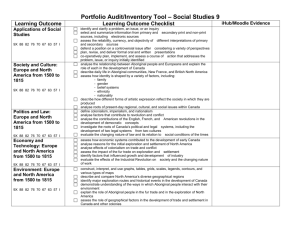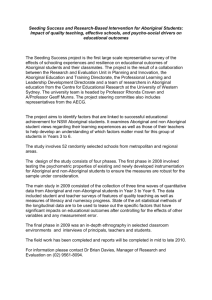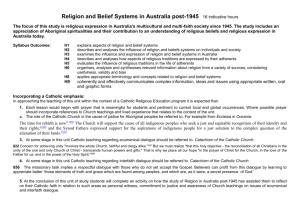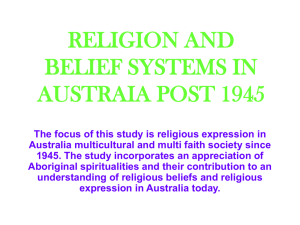File
advertisement
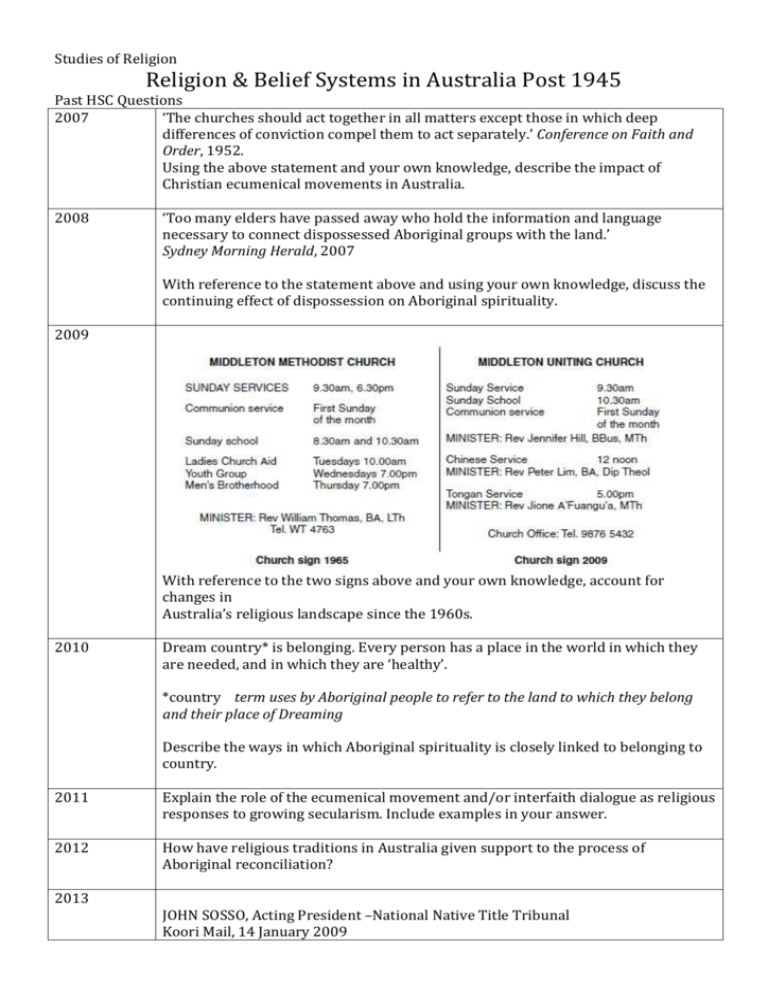
Studies of Religion Religion & Belief Systems in Australia Post 1945 Past HSC Questions 2007 ‘The churches should act together in all matters except those in which deep differences of conviction compel them to act separately.’ Conference on Faith and Order, 1952. Using the above statement and your own knowledge, describe the impact of Christian ecumenical movements in Australia. 2008 ‘Too many elders have passed away who hold the information and language necessary to connect dispossessed Aboriginal groups with the land.’ Sydney Morning Herald, 2007 With reference to the statement above and using your own knowledge, discuss the continuing effect of dispossession on Aboriginal spirituality. 2009 With reference to the two signs above and your own knowledge, account for changes in Australia’s religious landscape since the 1960s. 2010 Dream country* is belonging. Every person has a place in the world in which they are needed, and in which they are ‘healthy’. *country term uses by Aboriginal people to refer to the land to which they belong and their place of Dreaming Describe the ways in which Aboriginal spirituality is closely linked to belonging to country. 2011 Explain the role of the ecumenical movement and/or interfaith dialogue as religious responses to growing secularism. Include examples in your answer. 2012 How have religious traditions in Australia given support to the process of Aboriginal reconciliation? 2013 JOHN SOSSO, Acting President –National Native Title Tribunal Koori Mail, 14 January 2009 With reference to the quotation, outline the importance of Native Title legislation in achieving the objectives of the Land Rights movement 1. Discuss the relationship between kinship and the Dreaming in Aboriginal spiritualities. 2. Analyse the relationship between ceremonial life and the Dreaming in Aboriginal spiritualities. 3. Assess the impact of separation from the land on contemporary Aboriginal spiritualities. 4. Discuss the impact on the removal of Aboriginal children from their families on contemporary Aboriginal spiritualities. 5. Outline the history of the land rights movement and assess its importance for contemporary Aboriginal spiritualities. 6. Explain the relationship between the Dreaming and the land rights movement. 7. Outline the changing patterns of religious adherence from 1945 to the present 8. Analyse the effect on Christianity of the changing patterns of religious adherents from 1945 to the present 9. The graph shows the percentage of Australians who have identified with religions other than Christianity. Account for the trends shown in the graph. 10. Analyse the effect of immigration changing patterns of religious adherents from 1945 to the present 11. Analyse the effect of denominational switching on the changing patterns of religious adherents from 1945 to the present. 12. Explain the factors that have led to the growth in Pentecostalism in Australia. 13. Analyses the effect of the rise of New Age religions and the changing pattern of religious adherents from 1945 to the present. 14. "Many are still looking for some sense of spiritual direction...they just may be shuffling through a deck of tarot cards instead of rifling through the pages of the Bible". (Sunday Life 15 th July 2001) More and more Australians are turning away from mainstream religions. Analyse the reasons for this movement and discuss your understandings with reference to at least two alternative "new age" religions. 15. Account for the popularity of New Age religions in Australia. 16. Identify two examples of ecumenical developments in Australia since 1945. 17. Analyse the effect of secularism on the changing pattern of religious adherents from 1945 to the present. 18. Analyse the relationship between religious traditions and Aboriginal spiritualities in the process of reconciliation.








